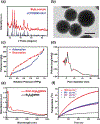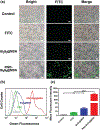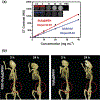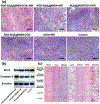Enhancing Osteosarcoma Killing and CT Imaging Using Ultrahigh Drug Loading and NIR-Responsive Bismuth Sulfide@Mesoporous Silica Nanoparticles
- PMID: 30102469
- PMCID: PMC6504251
- DOI: 10.1002/adhm.201800602
Enhancing Osteosarcoma Killing and CT Imaging Using Ultrahigh Drug Loading and NIR-Responsive Bismuth Sulfide@Mesoporous Silica Nanoparticles
Erratum in
-
Enhancing Osteosacoma Killing and CT Imaging Using Ultra High Drug Loading and NIR-Responsive Bismuth Sulfide @Mesoporous Silica Nanoparticles.Adv Healthc Mater. 2024 Apr;13(10):e2304500. doi: 10.1002/adhm.202304500. Epub 2024 Mar 9. Adv Healthc Mater. 2024. PMID: 38459806 No abstract available.
Abstract
Despite its 5-year event-free survival rate increasing to 60-65% due to surgery and chemotherapy, osteosarcoma (OS) remains one of the most threatening malignant human tumors, especially in young patients. Therefore, a new approach that combines early diagnosis with efficient tumor eradication and bioimaging is urgently needed. Here, a new type of mesoporous silica-coated bismuth sulfide nanoparticles (Bi2 S3 @MSN NPs) is developed. The well distributed mesoporous pores and large surface areas hold great promise for drug protection and encapsulation (doxorubicin (DOX), 99.85%). Moreover, the high photothermal efficiency of Bi2 S3 @MSNs (36.62%) offers great possibility for cancer synergistic treatment and highly near-infrared-triggered drug release (even at an ultralow power density of 0.3 W cm-2 ). After covalently conjugated to arginine-glycine-aspartic acid (RGD) peptide [c(RGDyC)], the NPs exhibit a high specificity for osteosarcoma and finally accumulate in the tumor cells (tenfold more than peritumoral tissues) for computed tomography (CT) imaging and tumor ablation. Importantly, the synergistic photothermal therapy-chemotherapy of the RGD-Bi2 S3 @MSN/DOX significantly ablates the highly malignant OS. It is further proved that the superior combined killing effect is achieved by activating the mitochondrial apoptosis pathway. Hence, the smart RGD-Bi2 S3 @MSN/DOX theranostic platform is a promising candidate for future applications in CT monitoring and synergistic treatment of malignant tumors.
Keywords: Bi2S3@MSN; X-ray computed tomography; mitochondrial apoptosis pathway; osteosarcoma; photothermal therapy-chemotherapy.
© 2018 WILEY-VCH Verlag GmbH & Co. KGaA, Weinheim.
Conflict of interest statement
Conflict of Interest
The authors declare no conflict of interest.
Figures








Similar articles
-
Bi2 S3 -Tween 20 Nanodots Loading PI3K Inhibitor, LY294002, for Mild Photothermal Therapy of LoVo Cells In Vitro and In Vivo.Adv Healthc Mater. 2018 Nov;7(22):e1800830. doi: 10.1002/adhm.201800830. Epub 2018 Sep 21. Adv Healthc Mater. 2018. PMID: 30240165
-
An RGD-modified hollow silica@Au core/shell nanoplatform for tumor combination therapy.Acta Biomater. 2017 Oct 15;62:273-283. doi: 10.1016/j.actbio.2017.08.024. Epub 2017 Aug 18. Acta Biomater. 2017. PMID: 28823719
-
Bi2S3-embedded mesoporous silica nanoparticles for efficient drug delivery and interstitial radiotherapy sensitization.Biomaterials. 2015 Jan;37:447-55. doi: 10.1016/j.biomaterials.2014.10.001. Epub 2014 Oct 26. Biomaterials. 2015. PMID: 25453972
-
Multi-stimuli responsive mesoporous silica-coated carbon nanoparticles for chemo-photothermal therapy of tumor.Colloids Surf B Biointerfaces. 2020 Jun;190:110941. doi: 10.1016/j.colsurfb.2020.110941. Epub 2020 Mar 4. Colloids Surf B Biointerfaces. 2020. PMID: 32169778
-
Deep-Level Defect Enhanced Photothermal Performance of Bismuth Sulfide-Gold Heterojunction Nanorods for Photothermal Therapy of Cancer Guided by Computed Tomography Imaging.Angew Chem Int Ed Engl. 2018 Jan 2;57(1):246-251. doi: 10.1002/anie.201710399. Epub 2017 Dec 1. Angew Chem Int Ed Engl. 2018. PMID: 29139182
Cited by
-
Targeted Delivery of PD-L1-Derived Phosphorylation-Mimicking Peptides by Engineered Biomimetic Nanovesicles to Enhance Osteosarcoma Treatment.Adv Healthc Mater. 2022 Dec;11(23):e2200955. doi: 10.1002/adhm.202200955. Epub 2022 Oct 3. Adv Healthc Mater. 2022. PMID: 36123781 Free PMC article.
-
Nanoparticle contrast agents for X-ray imaging applications.Wiley Interdiscip Rev Nanomed Nanobiotechnol. 2020 Nov;12(6):e1642. doi: 10.1002/wnan.1642. Epub 2020 May 22. Wiley Interdiscip Rev Nanomed Nanobiotechnol. 2020. PMID: 32441050 Free PMC article. Review.
-
Mesoporous Silica Nanoparticles for the Treatment of Complex Bone Diseases: Bone Cancer, Bone Infection and Osteoporosis.Pharmaceutics. 2020 Jan 20;12(1):83. doi: 10.3390/pharmaceutics12010083. Pharmaceutics. 2020. PMID: 31968690 Free PMC article. Review.
-
Bioinspired nanomedicines for the management of osteosarcoma: Recent progress and perspectives.Mater Today Bio. 2025 Mar 5;32:101607. doi: 10.1016/j.mtbio.2025.101607. eCollection 2025 Jun. Mater Today Bio. 2025. PMID: 40151805 Free PMC article. Review.
-
In vivo performance of gold nanoparticle-loaded absorbable inferior vena cava filters in a swine model.Biomater Sci. 2020 Jul 21;8(14):3966-3978. doi: 10.1039/d0bm00414f. Epub 2020 Jun 19. Biomater Sci. 2020. PMID: 32558854 Free PMC article.
References
-
- Kansara M, Teng MW, Smyth MJ, Thomas DM, Nat. Rev Cancer 2014, 14, 722. - PubMed
-
- Ma H, Jiang C, Zhai D, Luo Y, Chen Y, Lv F, Yi Z, Deng Y, Wang J, Chang J, Adv. Funct. Mater. 2016, 26, 1197.
-
- Jaque D, Martinez Maestro L, del Rosal B, Haro-Gonzalez P, Benayas A, Plaza JL, Martin Rodriguez E, Garcia Sole J, Nanoscale 2014, 6, 9494. - PubMed
Publication types
MeSH terms
Substances
Grants and funding
LinkOut - more resources
Full Text Sources
Other Literature Sources
Medical
Research Materials
Miscellaneous

